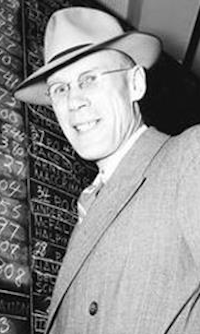Months before the end of the Second World War, the largest global conflict in human history, the Alberta government conducted a vote of Alberta-residents serving in the three branches of the Canadian armed forces. The vote was held to elect representatives of the Army, Navy and Air Force to serve as Members of the Alberta Legislature. Tens of thousands of Albertans were serving in the Canadian forces across the globe at the time.

The Soldier vote, also known as the Serviceman vote, was the second phase of the 1944 election that took place in 1945 and was sanctioned through Orders-in-Council from the provincial cabinet of Premier Ernest Manning. The cabinet order temporarily increased the number of seats in the Assembly from 57 to 60. A bill was passed through the Assembly after the vote in order to legally create the three new MLA positions.
Pressure from the opposition, including CCF MLA Elmer Roper, convinced the governing Social Credit Party to allow the servicemen vote and create the three MLA positions.
“There men are fighting for all we hold dear in democracy and political expediency is a sorry excuse for depriving people, particularly soldiers, the right to vote,” Calgary Liberal MLA Hugh MacDonald told the Legislature in March 1943, according to Edmonton Journal reports.
A similar vote was held following the 1917 provincial election, which elected two MLAs representing overseas servicemen and nurses, including Alberta’s second-ever woman MLA, Roberta MacAdams.

Voting conducted overseas was counted in England and sent to Edmonton by telegraph. In total, 7,985 votes were cast by servicemen (6,125 army votes, 1,207 air force votes, and 653 navy votes).
When the votes were counted, Captain James Harper Prowse was elected as the Army MLA, Wing Commander Frederick C. Colborne was elected as the Air Force MLA, and Chief Petty Officer Loftus Dudley Ward was elected to represent the Navy. They served as Independent MLAs until their terms expired in 1948.
Once in the Assembly, the MLAs raised issues ranging from housing, employment and education for veterans who returned to Alberta after the war ended.

Two of the MLAs continued their political careers after their terms ended in 1948, Mr. Prowse as a Liberal MLA from Edmonton until 1959 and Mr. Colborne as a Social Credit MLA from Calgary until 1971.
Mr. Colborne served in numerous cabinet positions, including Minister of Public Works and Minister of Municipal Affairs. He represented the Calgary-Centre constituency from 1959 until 1971. He was defeated in his bid for re-election in the new Calgary-Currie constituency in 1971.
Mr. Prowse served as Liberal Party leader from 1947 to 1958 and leader of the Official Opposition from 1952 to 1958. He would run for Mayor of Edmonton in 1959, finishing second to Mr. Roper, one of the strongest proponents of the Soldier vote. He was later appointed to serve in the Canadian Senate.
Saskatchewan also had a Soldier Vote
A similar vote was held in the Saskatchewan election of 1944, which saw three MLAs elected from geographic region of service (1 MLA for soldiers serving in Great Britain, 1 for soldiers serving the Mediterranean Theatre, and 1 for soldiers serving in Canada outside of Saskatchewan).

